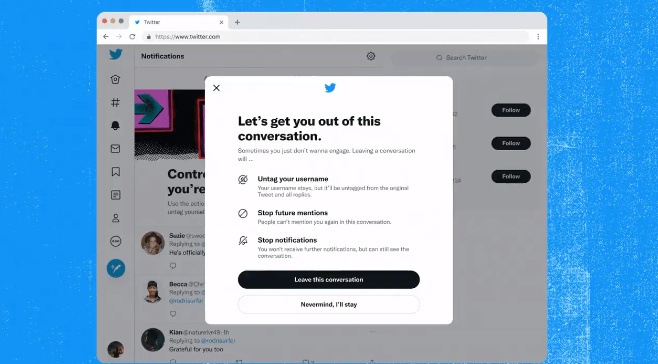SOCIAL
Twitter Launches Initial Test of New ‘Unmention’ Option, Enabling Users to Remove Themselves from Chats

After working on the option for the best part of the last year, Twitter has now released an initial live test of its new ‘unmention’ option, which will enable users to remove themselves from conversations if they no longer feel comfortable being involved.
How do you say “Don’t @ me,” without saying “Don’t @ me”?
We’re experimenting with Unmentioning—a way to help you protect your peace and remove yourself from conversations—available on Web for some of you now. pic.twitter.com/rlo6lqp34H
— Twitter Safety (@TwitterSafety) April 7, 2022
As you can see in this example, unmentioning yourself from a chat will see that:
- Your username is untagged from the original tweet and replies
- Users won’t be able to mention you again within the same reply chain
- You’ll no longer be notified about updates to the exchange
Your username will still appear, in text form, in the initial tweets that you were involved in, but you won’t be an active part of the exchange once unmention is active.
It could be a handy option to avoid the dreaded Twitter pile-on based on a misguided tweet, or simply to mute discussions which may be causing you distress. Essentially, it’s like the ‘Remove tag from photo‘ option, but for chats instead, which will give users the capacity to distance themselves from any direct association with selected Tweet discussions, helping to manage their in-app experience.
Twitter first unveiled the option in June last year, as part of an initial overview of coming tweet controls, which also included tools to avoid unwanted @mentions, and to stop anybody from mentioning you for a day a time, if needed.
Again, that could help users avoid mass criticisms and attacks in the app, and the mental stress that can come with such, and within this, Unmentioning, or removing yourself from a discussion, is another means to protect your sanity while engaging via tweet.
Twitter has also added options to mute keywords and users, to control who can reply to your tweets, while there are also now alerts available for potentially offensive comments.
In combination, these various tools will help to improve the Twitter experience, which has long been an issue of concern for the app.
Referred to at various times, by various people, as a ‘cesspit of hate’, among other colorful descriptors, part of the reason that some people are hesitant to join Twitter discussions is because they then stand the risk of being targeted, and being the focus of Twitter’s ‘Eye of Sauron’ for their 15-minutes of rage, which, for some, can be very overwhelming.
Twitter has some ambitious growth targets, and to meet them, it will need to attract new users, and if all people see when they log in is others being lambasted and attacked, that lessens the likelihood that they’ll consider joining in.
And when you also consider that some 80% of all tweets come from just 10% of active users, you can see how this trend then plays out. Twitter has many people tuning in, but far fewer willing to actually engage, at least partly due to fear of criticism if they say or do the wrong thing.
That’s not a good scenario, both for general interactions and for Twitter itself. And while these options won’t erase such habits from the app, they will at least give users more control over their experience.











You must be logged in to post a comment Login